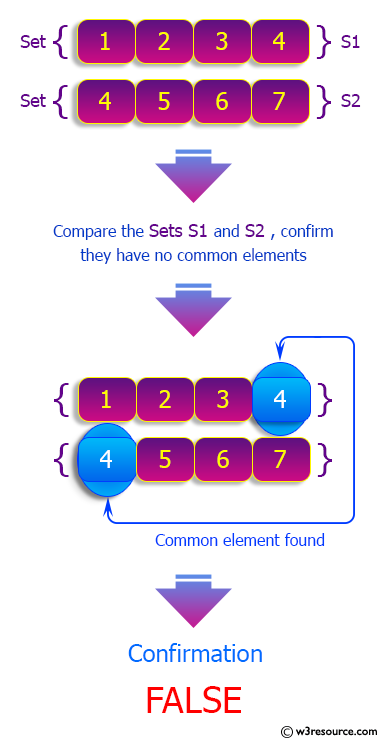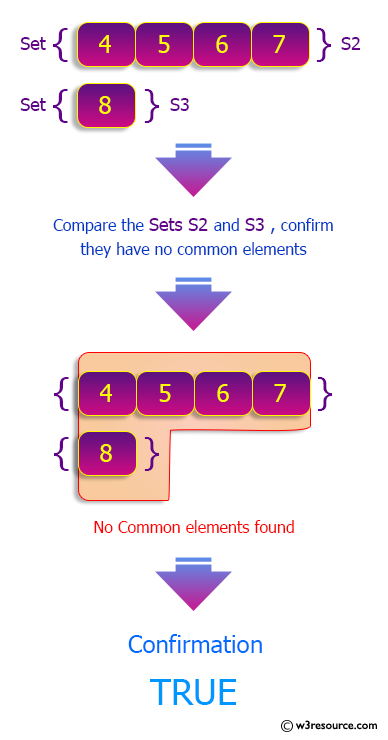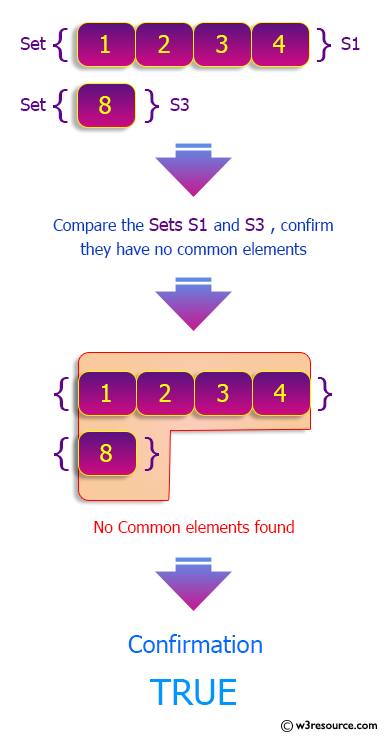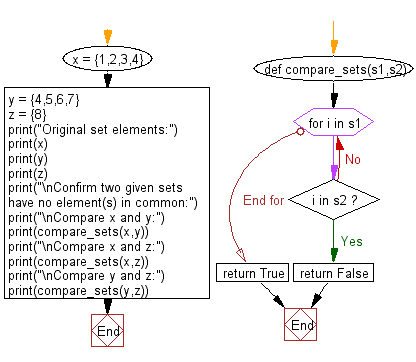Python: Check if two given sets have no elements in common
Python sets: Exercise-17 with Solution
Write a Python program to check if two given sets have no elements in common.
Sample Solution-1:
Python Code:
x = {1,2,3,4}
y = {4,5,6,7}
z = {8}
print("Original set elements:")
print(x)
print(y)
print(z)
print("\nConfirm two given sets have no element(s) in common:")
print("\nCompare x and y:")
print(x.isdisjoint(y))
print("\nCompare x and z:")
print(z.isdisjoint(x))
print("\nCompare y and z:")
print(y.isdisjoint(z))
Sample Output:
Original set elements:
{1, 2, 3, 4}
{4, 5, 6, 7}
{8}
Confirm two given sets have no element(s) in common:
Compare x and y:
False
Compare x and z:
True
Compare y and z:
True
Pictorial Presentation:



Visualize Python code execution:
The following tool visualize what the computer is doing step-by-step as it executes the said program:
Sample Solution-2:
Python Code:
def compare_sets(s1,s2):
for i in s1:
if i in s2:
return False
return True
x = {1,2,3,4}
y = {4,5,6,7}
z = {8}
print("Original set elements:")
print(x)
print(y)
print(z)
print("\nConfirm two given sets have no element(s) in common:")
print("\nCompare x and y:")
print(compare_sets(x,y))
print("\nCompare x and z:")
print(compare_sets(x,z))
print("\nCompare y and z:")
print(compare_sets(y,z))
Sample Output:
Original set elements:
{1, 2, 3, 4}
{4, 5, 6, 7}
{8}
Confirm two given sets have no element(s) in common:
Compare x and y:
False
Compare x and z:
True
Compare y and z:
True
Flowchart:

Visualize Python code execution:
The following tool visualize what the computer is doing step-by-step as it executes the said program:
Python Code Editor:
Have another way to solve this solution? Contribute your code (and comments) through Disqus.
Previous: Write a Python program to check if a given value is present in a set or not.
Next: Write a Python program to check if a given set is superset of itself and superset of another given set.
What is the difficulty level of this exercise?
Test your Programming skills with w3resource's quiz.
Python: Tips of the Day
Find current directory and file's directory:
To get the full path to the directory a Python file is contained in, write this in that file:
import os dir_path = os.path.dirname(os.path.realpath(__file__))
(Note that the incantation above won't work if you've already used os.chdir() to change your current working directory, since the value of the __file__ constant is relative to the current working directory and is not changed by an os.chdir() call.)
To get the current working directory use
import os cwd = os.getcwd()
Documentation references for the modules, constants and functions used above:
- The os and os.path modules.
- The __file__ constant
- os.path.realpath(path) (returns "the canonical path of the specified filename, eliminating any symbolic links encountered in the path")
- os.path.dirname(path) (returns "the directory name of pathname path")
- os.getcwd() (returns "a string representing the current working directory")
- os.chdir(path) ("change the current working directory to path")
Ref: https://bit.ly/3fy0R6m
- New Content published on w3resource:
- HTML-CSS Practical: Exercises, Practice, Solution
- Java Regular Expression: Exercises, Practice, Solution
- Scala Programming Exercises, Practice, Solution
- Python Itertools exercises
- Python Numpy exercises
- Python GeoPy Package exercises
- Python Pandas exercises
- Python nltk exercises
- Python BeautifulSoup exercises
- Form Template
- Composer - PHP Package Manager
- PHPUnit - PHP Testing
- Laravel - PHP Framework
- Angular - JavaScript Framework
- Vue - JavaScript Framework
- Jest - JavaScript Testing Framework
